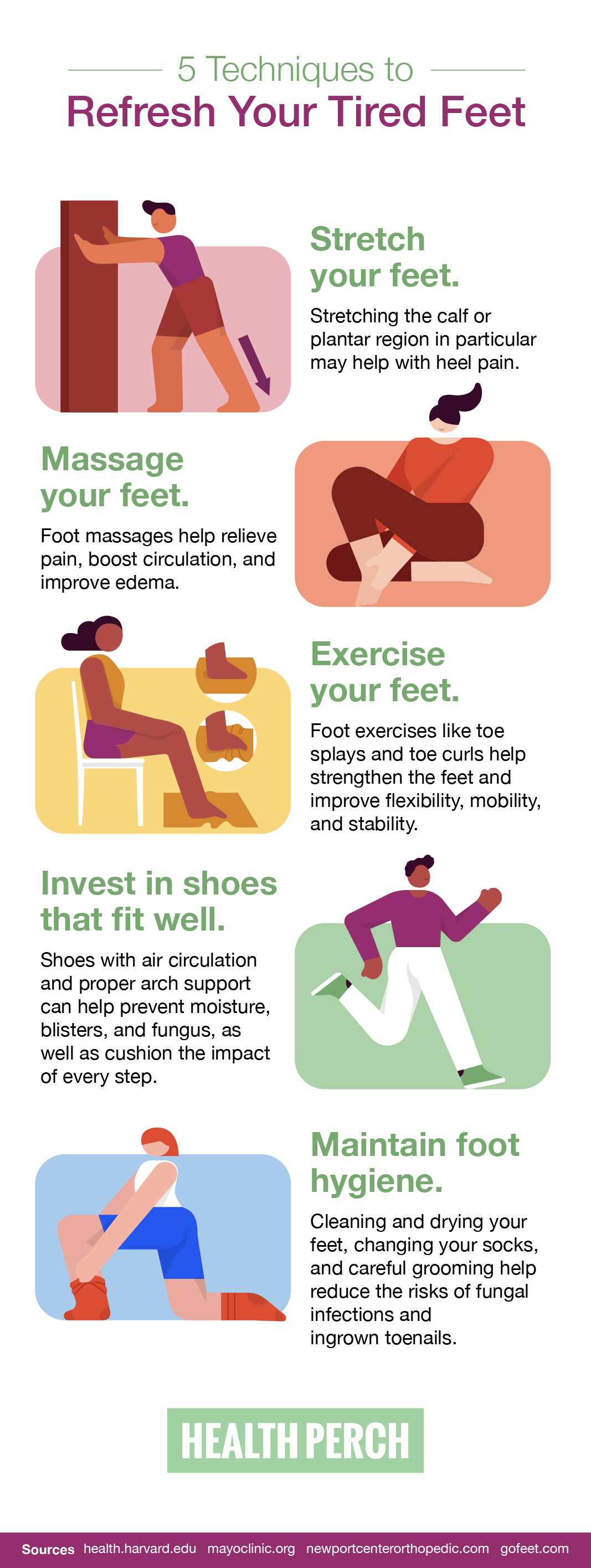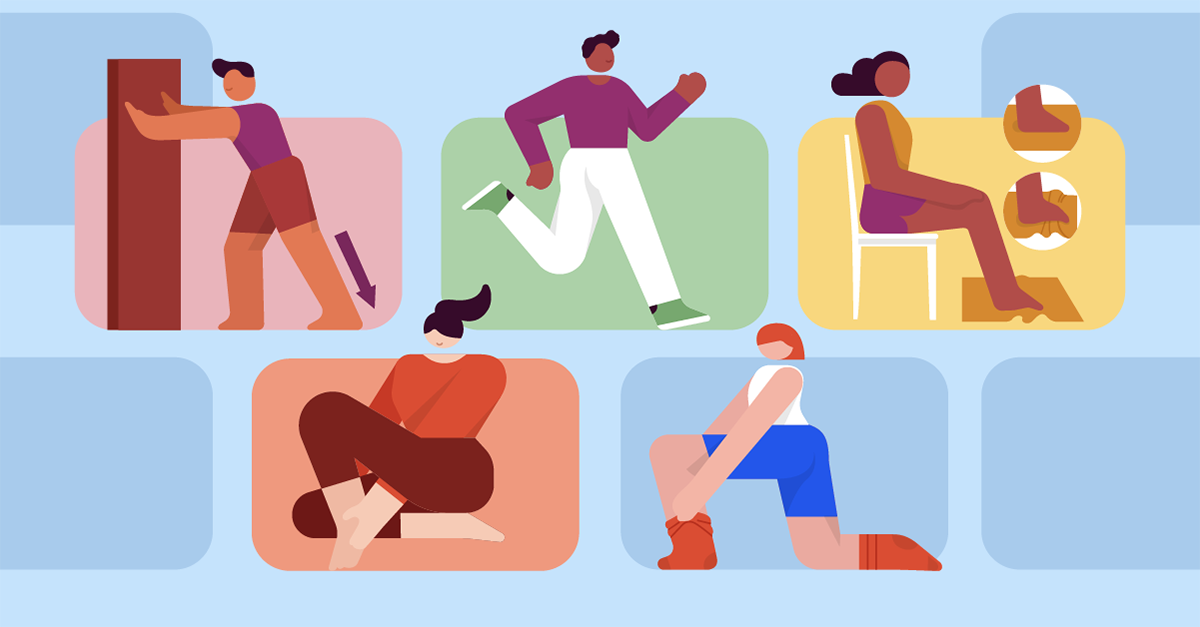Sometimes, mustering up the energy to crawl out of bed is a challenge within itself. But dealing with aching feet before your day even starts? It’s disheartening, to say the least, and makes getting out of bed even harder! Thankfully, there are plenty of methods to try to help keep your feet healthy, happy, and ready for any path you take.
Below, we’ll provide an overview of common foot ailments and conditions, plus techniques that can help prevent or alleviate foot pain.
Common Foot Ailments and Conditions
Athlete’s foot
You’ve probably heard of athlete’s foot. It’s a common, contagious fungal infection that may appear as either white, soggy skin between the toes; dry, scaly growth on the soles; or reddening and blistering all over the foot. It causes skin to itch, flake, and fissure. It also can spread to other parts of the body and other people. The fungi, called dermatophytes, often grow in warm, humid settings such as wet socks — hence its affiliation with locker rooms and active lifestyles. And it’s even more common than many people think: Anywhere between three to 15 percent of the population has athlete’s foot, and 70 percent of the general population will get it at some point in their life.
Plantar fasciitis
Looking at the anatomy of your foot, the plantar fascia is the thick band of tissue that stretches along the bottom of your foot and connects the heel bone to the toes. When inflamed, it causes sharp heel pain — called plantar fasciitis. Often, the pain is most severe after waking up, and it lessens after some activity. It can also be triggered from standing for a long period of time or getting up after sitting. The cause of this condition has yet to be determined, but the repeated stretching and tearing of this area can result in pain and inflammation.
Bunions
Bunions are swollen, tender bumps that form at the base of the big toe due to misaligned joints. The misalignment causes the big toe to move against other toes, possibly causing pain, pressure, and deformation of the foot. Sometimes, a bunion can even damage nerves, which numbs the big toe. More common in women than in men, bunions often turn up when people have weaker connective tissue, a short Achilles tendon, short calf muscles, joint disease, splayfoot, or flat feet. Tight shoes can also contribute to the development of bunions and worsen the issue.
Heel spurs
Heel spurs are bony growths that protrude on the underside of the heel bone, inside your foot. They are a response to stressors on foot ligaments like plantar fasciitis, the repeated tearing of the covering of your heel bone, or gait disorders. Spurs occur when the body builds extra bone tissue to compensate for the strain. Most people don’t feel pain from heel spurs, but if pain is present, it tends to feel like plantar fasciitis: sharp at first and easing as the day goes on. Heel spurs can’t be cured, but they can be prevented or treated non-surgically.
Ingrown toenails
Ingrown toenails occur when part of the nail grows down into the skin, causing pain, inflammation, and infection. Teenagers and young adults are most commonly affected, but an ingrown toenail can happen to people of any age. If left untreated, it may worsen and even result in a disability. The cause is often improper nail trimming, but ingrown toenails can also result from tight shoes, poor foot hygiene, certain medical conditions, and more. The level of pain ranges from difficulty walking to not being able to walk without assistance, depending on the stage. Treatments include non-surgical and surgical methods depending on the severity.

Techniques to Help Prevent or Alleviate Foot Pain
Many of the foot ailments and conditions mentioned above may be treated with these simple preventative or post-problem measures.
Stretching
Stretching the calf or the plantar region may help with heel pain. Stretch your calves by facing a wall with both hands extended out, then bending your legs forward one after the other for three minutes, three times a day, or five 20-second intervals twice a day. Additionally, night splints that keep the ankle in a neutral position, passively stretching the calf and plantar fascia, can also help.
Massaging
Foot massages are a relaxing solution to aching feet. It may not be feasible to budget for a trip to a spa whenever you feel pain, but self-massages can solve that issue easily. From arch rubs to toe bends, there are many techniques and tools for your troubles. Massages also help with circulation and edema, which is swelling in the feet and ankles due to excess fluid in the tissues. Edema occurs most often in pregnant people and adults around the age of or older than 65.
Exercising
Like the rest of the body, your feet can be strengthened by exercise, reducing the chances of any pain brought on by a tough day. Foot exercises also benefit runners, including improved flexibility, better mobility, and better stability. One exercise is toe splays, which require spreading your toes out for 10 seconds, 10 times. Another is toe curls, where you curl your toes around an item (such as a towel) and pull it toward you, repeating the process five times.
Making sure your shoes fit correctly
Well-fitting shoes can manage multiple ailments, such as bunions, heel spurs, and ingrown toenails. Try to wear shoes that allow air circulation, which prevents moisture, blisters, and fungus, and offers proper arch support, which cushions the impact of each step. If it’s hard to find the perfect pair, ask your doctor for custom inserts, insoles, or compression socks for better support and leg circulation.
Maintaining good foot hygiene
Besides eliminating bad smells and unsightly appearances, careful foot care can prevent pain, too. For example, cleaning and drying your feet, as well as changing your socks every day, help reduce the risk of fungal infections. Regarding nails, careful trimming lessens the chances of ingrown toenails. Foot care doesn’t have to be a chore — you can even try an at-home pedicure for fun!
Conclusion
Unfortunately, people tend to ignore their feet until they hurt. Because they’re essential to your mobility, helping you get from point A to point B, they deserve as much care as the rest of your body. If your foot pain or condition stays the same or worsens over time, however, consult a medical professional for other options to heal your feet.
